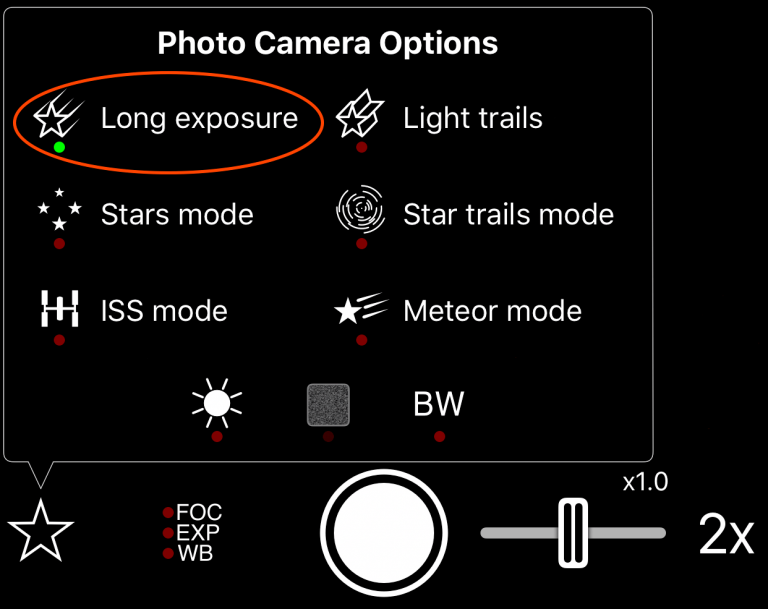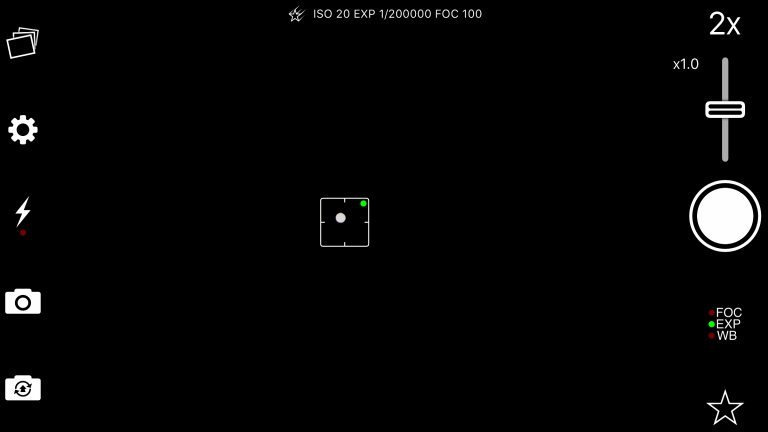How To Photograph The Solar Eclipse On Your iPhone or iPad with NightCap
Eclipses are rare, and total eclipses are often a once in a lifetime experience. Our guide will show you how to set up NightCap Camera on your iPhone or iPad to take a sequence of photos automatically, so you can focus on watching the eclipse and not the screen.
The screenshots with these instructions show the iPhone interface, but will work exactly the same for the iPad too.
Images kindly provided by Jim Opalek, using NightCap and a solarscope during the American total eclipse of 2017.
Please note:
The iPhone/iPad camera is very small, and while you should get good photos it won’t be comparable to DSLR cameras with big, expensive lenses. Also, the lens gives quite a wide view which means the sun will be quite small in your photos.
Essential advice
-
Use a tripod, or some other way to keep the device still during the eclipse.
-
Protect the camera lens with a solar filter. Lenses focus the sun’s energy to a point. You can start a fire with a magnifying glass. The camera’s lens is a lot smaller and is unlikely to cause a fire, but you should still protect the camera during the eclipse as you’ll be leaving it pointed at the sun for at least a few minutes.
-
If you plan to leave the camera running for a long time time, we recommend putting something in front of your device to shade it (remember to keep the camera clear!) An iPhone or iPad in direct sunlight will get hot, and taking photographs also creates heat. It won’t cause any damage but if it gets too hot it will turn itself off and you won’t be able to take any photos!
-
You’ll be setting everything up in full sun, and the sun will be right behind your screen. That will make it difficult to see what you’re doing. Consider making a shield around your screen to block the background light so you can see easily.
-
If the sun will be very high in the sky in your location, that means your device will be pointing almost straight up. Check your tripod will work at that angle, and how easy it is to see and use the screen too.
You should remove the solar filter from the camera just before totality so the camera can get clear photos during the period of darkness. Replace the filter afterwards.
Taking a sequence of photos automatically
You’ll want to watch the eclipse, not the screen. Set NightCap Camera to take a sequence of photos automatically, and you can concentrate on the eclipse while the app records it. NightCap Camera has an Interval Programmer that lets you do this. Here’s how to set it up.
1. Open the in-app settings
Just tap the button with the cog icon:

2. Turn on the Interval Programmer.
This sets the camera up to take a sequence of photos automatically.

3. Set the Interval Programmer options
The 3 numbers under the interval programmer set the sequence up. Set them to:
-
Shots to take: Infinite (∞). When it’s set to infinite shots, you just tap the shutter to start taking photos and again to stop.
- Exposure time: 3 seconds. This will take a 3 second exposures.
- Interval between shots: 0 seconds. This means the camera takes photos continuously, without waiting between shots.
4. Set quality to JPEG or HQ JPEG.
HQ is slightly higher quality, but uses 2-3x more storage space. Standard JPEG is fine for most people.

Why not TIFF? It’s technically better, but the difference is very minimal and it takes a lot more time to save, meaning it delays taking the next photo and we might miss a good shot. It also uses far more storage space.
You can close the Settings screen now by tapping the cog icon.
Devices with multiple cameras: Use the 2x camera
If you’re lucky enough to have an iPhone or iPad with a telephoto lens, use the 2x (zoom) camera. This will give you much better photos, as the sun will be 2x bigger.

Note that some devices have ultra-wide (0.5x) lenses but not telephoto (2x). In this case you should use the 1x lens.
Turn on Long Exposure mode for best quality
Long Exposure mode takes lots of photos extremely quickly, and blends them together. This produces very high quality photos, and eliminates a lot of image noise in very low light. It does however require a tripod to avoid blurring the shot.
Open the Camera Options panel, where you’ll find the special camera modes.

Turn on Long Exposure mode. This will give better quality if the image is very dark during totality.

Set exposure and focus
Lastly, tap on the sun to set the focus and exposure point. Zoom in to make sure it’s correctly focused (you can slide your finger left and right near the bottom of the screen to adjust if not).

Then lock focus (tap the “FOC EXP WB” button to show the locks, then tap FOC. A green light means it’s locked and won’t change during the eclipse.)
Make sure exposure is not locked (the light should be dark red next to EXP). During the eclipse the light level will change from daylight to very dark, so it’s essential that the camera is free to adjust or you’ll get black photos during totality.

Adjusting the picture if it’s too bright or too dark
Depending on how bright the sun is, you may need to reduce ISO or exposure using the manual camera controls to see clearly. If you haven’t used manual controls before, don’t worry – it’s very easy and you can simply adjust until it looks good.
Simply slide your finger up and down on the left side of the screen to adjust ISO or the right to adjust exposure. Up increases the value and brightens the image, down does the opposite.
ISO and exposure both adjust photo brightness, but in different ways. There’s a simple rule to follow:
- If you want a brighter photo, increase exposure first. Increase ISO once you get to maximum exposure.
- If you want a darker photo, decrease ISO first. Decrease exposure once you get to minimum ISO.
Note that adjusting the exposure will lock it in place and the camera will no longer adjust automatically during the eclipse. You’ll need to adjust it as necessary, or unlock exposure to go back to automatic mode.
Taking photos
Once you’ve got everything set up, taking the photos is simple. Just tap the shutter button once to start taking photos, then tap it again after the eclipse has finished.
You’ll see the shutter button repeatedly activate and count through the 3 second exposure as it takes photos, and you’ll see the photo counter at the top slowly increase. You’ll also hear the shutter firing – a beep means the next exposure has started, and the shutter noise means it’s finished taking a shot.
General tips:
- Set your device to Airplane Mode! A phone call or email can cause vibration, spoiling the photos, and could stop the app from recording.
- Make sure you have no reminders, calendar appointments etc set during the eclipse too!
- Check you have a full battery before the eclipse. It’s worth attaching an external battery or plugging into the mains if you want to be extra safe.
- Make sure you have plenty of storage space free too. To check, open the Settings app, and go to “General”, then “Storage & iCloud Usage”. The “Available” number under “STORAGE” tells you how much space you have left. If it’s less than 2GB you might want to delete some unused apps, videos or music to make a bit more space available.
- Try this out as a “dry run”. A bit of practice before the actual eclipse will ensure you get it right on the day.
- If you plan to take photos manually instead of using the interval programmer, use a remote shutter control. Tapping the shutter button can cause vibration, which could spoil the perfect shot.Any headphones with a remote (including the ones that come with iPhones and bluetooth headphones!) can be used, and any bluetooth remote shutter control compatible with iPhone should work. You need to turn on volume shutter control in the in-app preferences, then just press the volume up or down buttons to take a shot.

Not got NightCap Camera yet?